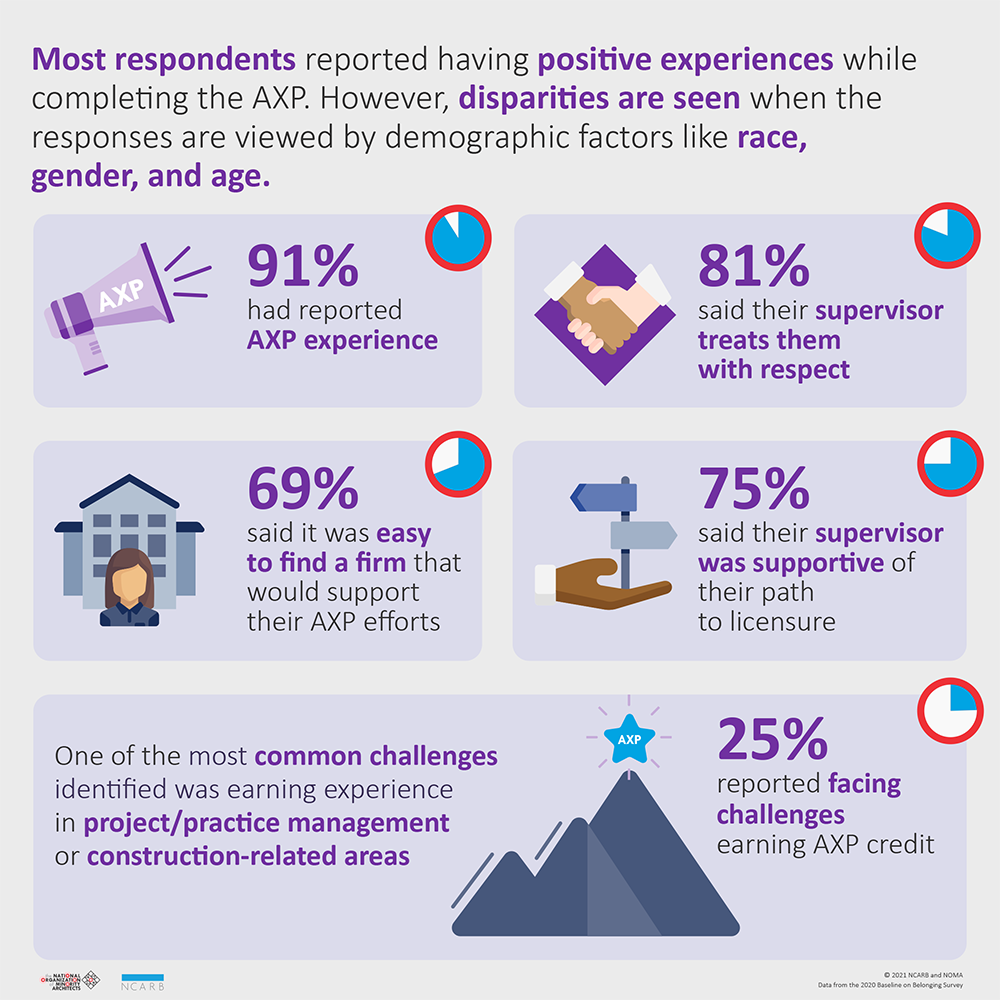The National Council of Architectural Registration Boards (NCARB) and National Organization of Minority Architects (NOMA) released an in-depth report exploring factors that impact equity, diversity, and inclusion for candidates gaining professional architecture experience.
The Baseline on Belonging: Experience Report reveals that interplay between factors such as race, age, and firm size can have a significant impact on an individual’s ability to navigate the Architectural Experience Program® (AXP®), which is a key step to earning an architecture license in the United States. Over the coming months, NOMA and NCARB will continue to analyze the survey results and release in-depth reports on four additional key topic areas: examination, education, firm culture, and career development. Read the Summary
In 2019, just over 11 percent of architects in the United States identified as a racial or ethnic minority, according to NCARB by the Numbers. And while representation along most career stages has increased slowly over the past several years, candidates of color are still 31% more likely to stop pursuing licensure. Understanding the factors that lead to attrition along the path to earning a license is the focus of the Baseline on Belonging study, which is based on results from a joint survey conducted by NCARB and NOMA in early-2020. Early findings from the survey were released in the summer of 2020.
“Understanding the challenges and hurdles that prevent minorities from achieving architecture licensure is of essential importance to NOMA,” said NOMA President and Gensler Senior Associate Jason Pugh, NOMA, AIA, AICP, LEED AP. “We are strongly committed to finding effective ways to reduce the barriers to licensure for all minority architects, especially Black female architects, who remain the least represented population in the profession. While the number of newly licensed Black architects has flatlined over the last couple of decades, we are pleased to see an increase in overall diversity for those starting the licensure process. With NCARB’s documentation and new understanding of the challenges candidates face on the path to licensure, the next steps forward must include a definitive action plan we can collectively harness to streamline the process going forward.”

To complete the AXP, candidates must earn 3,740 hours across six practice areas and frequently rely on their employers to provide opportunities in the necessary areas. By exploring respondents’ experiences navigating the AXP, NCARB and NOMA hope to identify areas where the program—as well as firms and supervisors—may create unintended barriers.
“NCARB is dedicated to ensuring the path to licensure is equitable and accessible to all,” said FY21 NCARB President Robert M. Calvani, FAIA, NCARB, Hon. FCARM. “It is a privilege to work together with NOMA to address this important issue for our profession.”
With over 5,000 complete responses (including over 2,800 from people of color and nearly 2,500 from women), the survey highlighted several key findings for additional study and exploration:
- Overall, survey participants reported positive experiences completing the AXP. However, filtering the data by demographic factors (such as race/ethnicity, gender, and age) reveals disparities that range from slight to significant.
- When responses are segmented by race/ethnicity the largest disparities are seen in the variety of experience opportunities provided and supervisor support.
- Age is the most significant factor impacting a candidate’s progression through the AXP, with nearly half of respondents over the age of 55 reporting challenges earning experience.
- Women of color—especially African American women—frequently face greater barriers than white women or men of color.
- African American women are consistently less likely to report having a positive supervisor relationship than respondents of other demographic groups.
- Firm size can have a variety of impacts on AXP support, with some positives and negatives seen for each firm size. However, African Americans working at large firms typically report less challenges than those working at small firms.
- White candidates take slightly longer to complete the experience requirement than candidates of other races/ethnicities, but they are still younger when they start and complete the AXP.
These findings are a first step in identifying and addressing pinch points during the experience component of the licensure path. To better understand the underlying cause of the disparities highlighted in the report, NCARB and NOMA will conduct focus groups and follow-up surveys. Many aspects of earning professional experience are inseparable from individual firm culture, so necessary solutions to experience-related impediments may vary widely.
“The path to professional licensure as an architect is a challenging one for most, and NOMA is keenly interested in helping to remove unnecessary barriers to entry for those who wish to design the spaces where we all live, work, and play,” said past NOMA President and HOK Principal Kimberly Dowdell, AIA, NCARB, LEED AP. “We appreciate the opportunity to partner with NCARB, leveraging their in-depth data analysis capabilities, to determine pinch points in the licensure process, particularly for under-represented candidates. In collaboration with NCARB and the other architecture anchor institutions, NOMA looks forward to the process of collectively evaluating the survey data to effectively craft policies designed to facilitate a more accessible path to licensure for all people.”
To learn more about next steps and how to participate in further study, subscribe to our mailing list. To learn more about the Baseline on Belonging study and download the full report, visit ncarb.org/belong.




